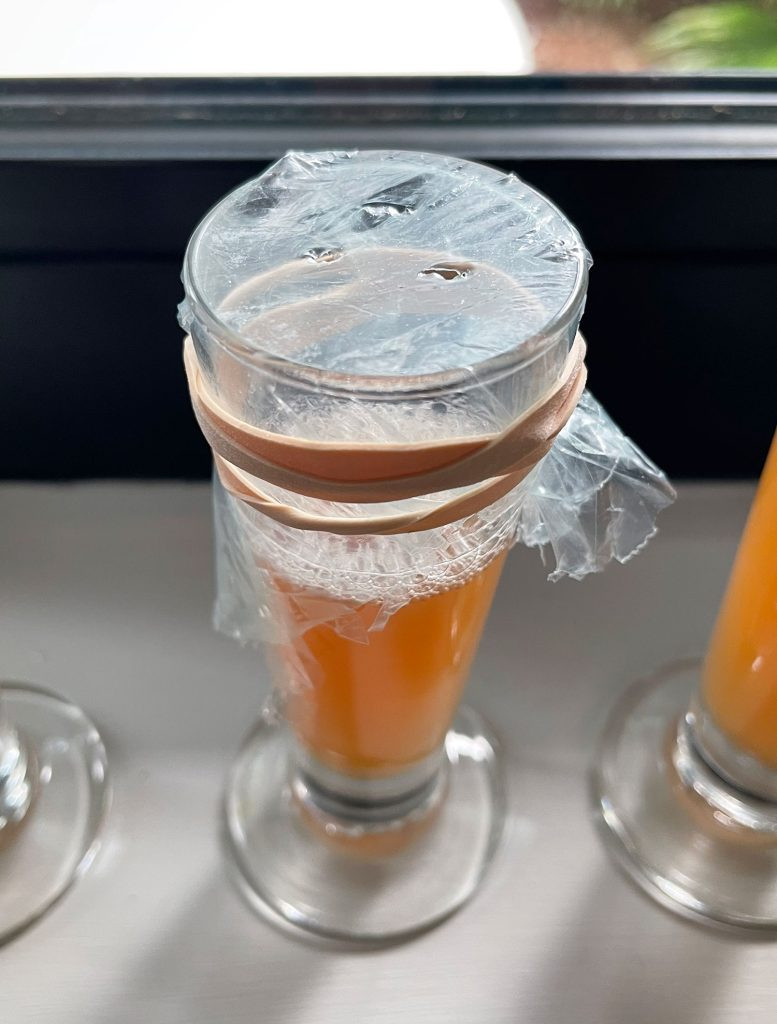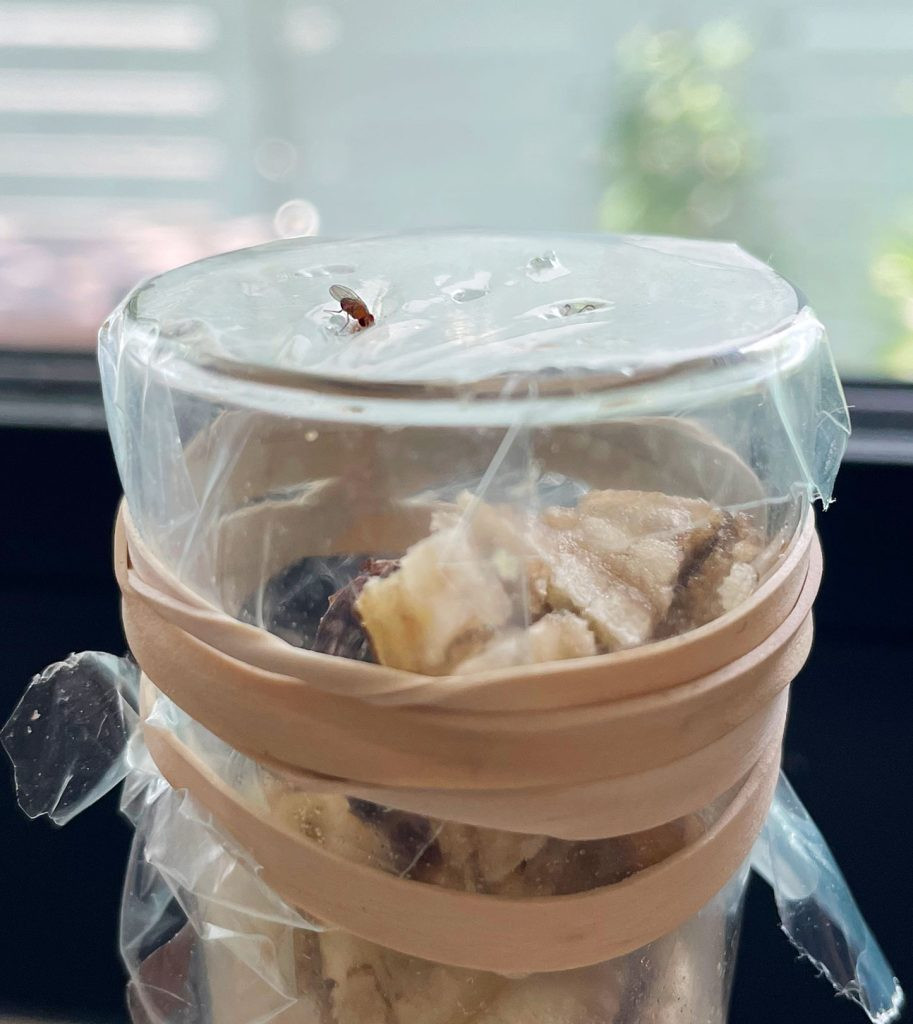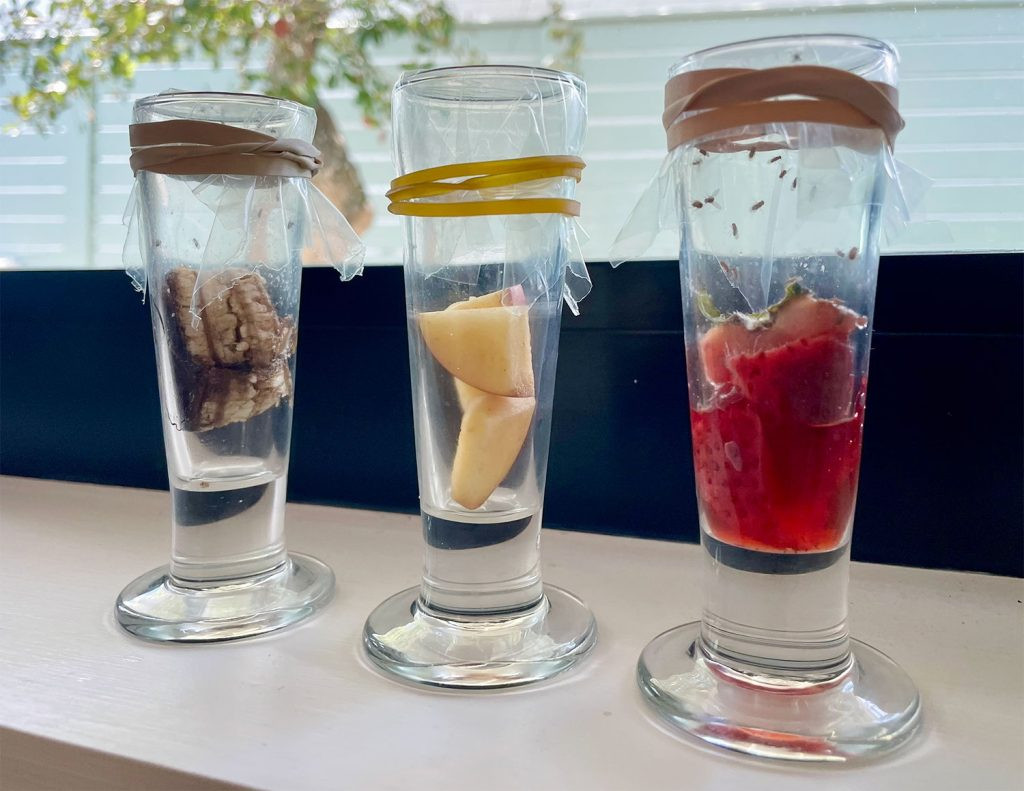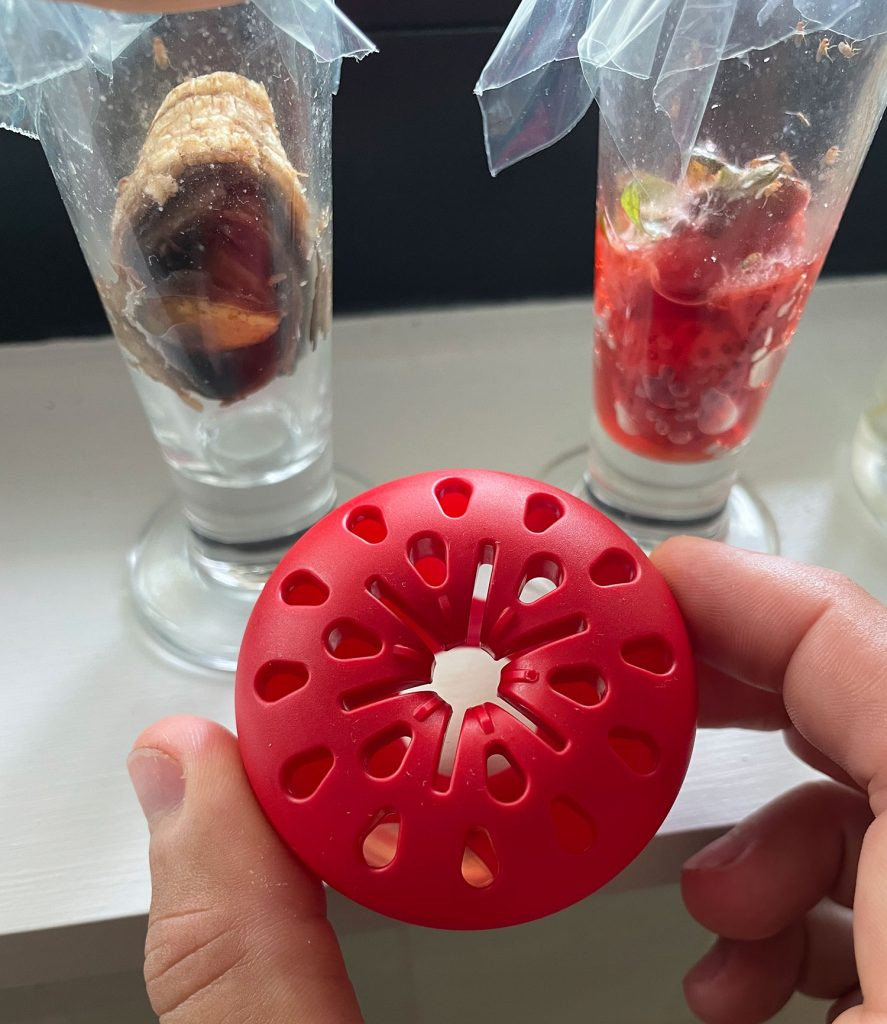Getting rid of fruit flies in the house is a common concern, and at flyermedia.net, we understand the annoyance these tiny pests can cause. We offer practical solutions to eliminate these pests quickly and efficiently, focusing on easy-to-implement methods and fruit fly control. Discover how to combat fruit fly infestations and implement preventive measures for a pest-free home. We’ll also share some tips for preventing a fruit fly infestation in the first place.
1. Understanding Fruit Flies
1.1. What Exactly Are Fruit Flies?
Fruit flies are small flying insects drawn to ripe fruits and vegetables. They are also attracted to fermented beverages like beer, wine, and juice. These pests, roughly the size of a grain of rice, resemble small, tan, or brownish houseflies with red eyes. They typically appear in the summer and late fall, coinciding with the fruit season.
A minor fruit fly problem can quickly escalate because females can lay hundreds of eggs that hatch in as little as 12 hours. These pests can reach adulthood within days, leading to rapid infestation. Eliminating fruit flies swiftly is essential to prevent this escalation.
1.2. Identifying Different Pests: Fruit Flies Vs. Fungus Gnats Vs. Drain Flies
It’s easy to confuse fruit flies with other common household pests, such as fungus gnats and drain flies. Correctly identifying these pests ensures that you use the appropriate elimination method. The easiest way to distinguish them is by where you spot them and what larger insect they resemble.
- Fruit Flies: Look like small flies and are usually found near fruit bowls, trash cans, or other food sources.
- Drain Flies: Resemble small fuzzy moths and are typically found near sinks and drains.
- Fungus Gnats: Look like small mosquitos and are usually found near houseplants, where they breed in damp soil.
If you’re unsure, setting up one of the traps mentioned in this article can help you identify them. If the trap attracts the pests, you likely have fruit flies.
2. Effective DIY Fruit Fly Traps
2.1. Why Choose DIY Fruit Fly Traps?
Opting for DIY fruit fly traps is a practical solution for pest control for several reasons. First, these traps are incredibly budget-friendly. They require common household items, so you don’t have to spend money on expensive commercial products. Second, DIY traps are easy to make and set up, making them accessible to everyone. Third, these traps are a non-toxic way to combat pests in your home. Lastly, DIY traps can be tailored to your specific needs, allowing you to experiment with different attractants and trap designs to find what works best for you.
Getting rid of fruit flies doesn’t have to be complicated or expensive. You need household supplies and patience. Each trap follows the same formula: attract the fruit fly + keep it from escaping. Here are four effective DIY fruit fly traps you can try at home:
- Funnel Trap
- Plastic Wrap Trap
- Dish Soap Trap
- Rotting Fruit Trap
 Four different DIY fruit fly traps are set up on a windowsill.
Four different DIY fruit fly traps are set up on a windowsill.
Some traps work faster than others, and eradicating your issue may take several days.
2.2. #1: The Funnel Fruit Fly Trap
2.2.1. How Does the Funnel Trap Work?
The funnel trap lures fruit flies into a container through a small hole in a paper funnel. The flies can easily enter, but the narrow opening makes it difficult for them to escape. This design effectively traps the pests inside.
2.2.2. Materials Needed for the Funnel Trap
- Small clear jar, cup, or container (preferably with a narrow opening)
- Piece of paper or cardstock
- Tape
- Scissors
- Apple cider vinegar (ACV)
2.2.3. Step-by-Step Instructions to Build a Funnel Trap
- Select Your Container: Use a small, clear container like an old food jar or plastic soda bottle. A narrow opening is ideal for this method.
- Add Apple Cider Vinegar: Pour a small amount of apple cider vinegar, old beer, or wine into the container. The scent will attract the fruit flies.
- Create Your Funnel: Roll a small piece of paper or cardstock into a cone shape with a tiny opening at the tip. Secure the cone with tape. The opening should be about the size of a grain of rice.
- Set Up Your Funnel: Place the paper cone into the container’s opening. Adjust the funnel so it rests on the opening’s edges without touching the ACV, ensuring no gaps for escape.
- Optional Outdoor Release: Carefully take the trap outside without disturbing the funnel, then remove the funnel to let the flies escape.
Using a store-bought funnel is an alternative, but its opening may be too large, allowing too many fruit flies to escape.
2.3. #2: The Plastic Wrap Fruit Fly Trap
2.3.1. How Does the Plastic Wrap Trap Work?
The plastic wrap trap uses the scent of apple cider vinegar to attract fruit flies. They enter through small holes in the plastic wrap but struggle to find their way out.
2.3.2. Materials Needed for the Plastic Wrap Trap
- Small clear jar, cup, or container
- Rubber band
- Plastic wrap or plastic bag
- Toothpick
- Apple cider vinegar (ACV)
2.3.3. Step-by-Step Instructions to Build a Plastic Wrap Trap
 DIY fruit fly trap with apple cider vinegar and plastic wrap
DIY fruit fly trap with apple cider vinegar and plastic wrap
- Choose Your Container: Find a small clear jar, cup, or glass container. Anything works, and it doesn’t need to be large. Using something clear makes it easier to see the flies your trapping, but an old soda or beer can works too.
- Add Apple Cider Vinegar: Pour apple cider vinegar into your container. The scent will attract the flies. Old beer or wine also works too, but not regular white vinegar.
- Cover with Plastic: Tightly cover the opening with plastic wrap and secure it with a rubber band. Saran wrap works, but you can also cut scraps from a plastic bag.
- Poke Small Holes: Use a toothpick to poke a few small holes in the top of the plastic. You don’t need a lot, but ensure they are big enough for a fly to fit through.
- Optional Outdoor Release: Carefully take the trap outside without removing the plastic wrap cover, then remove it to let the flies escape.
Alternatively, poke a hole in a metal jar lid using a hammer and nail.
2.4. #3: The Dish Soap Fruit Fly Trap
2.4.1. How Does the Dish Soap Trap Work?
Unlike the other traps, the dish soap trap doesn’t require a cover. Instead, it relies on a soapy surface to trap the pests. This method doesn’t allow you to release the flies, as they become coated in soap.
2.4.2. Materials Needed for the Dish Soap Trap
- Small container, bowl, or dish
- Dish soap
- Apple cider vinegar (ACV)
2.4.3. Step-by-Step Instructions to Build a Dish Soap Trap
- Pour Apple Cider Vinegar: Fill the bottom of a small container, bowl, or dish with apple cider vinegar to attract the fruit flies.
- Add Dish Soap and Mix: Add several drops of dish soap to the ACV and mix to create a soapy solution. Flies landing on the mixture will find it difficult to fly away.
You can combine this method with the plastic wrap or funnel trap by adding dish soap to the apple cider vinegar before covering the top, providing another way for the flies to get stuck.
2.5. #4: The Rotting Fruit Trap
2.5.1. How Does the Rotting Fruit Trap Work?
This trap uses the strong attraction fruit flies have to rotting fruit. It involves substituting apple cider vinegar with actual fruit, which fruit flies love.
2.5.2. Materials Needed for the Rotting Fruit Trap
- Small glass jar, cup, or container
- Plastic wrap or paper funnel, depending on your chosen trap
- A small fruit scrap, such as a banana peel or apple slice
2.5.3. Step-by-Step Instructions to Build a Rotting Fruit Trap
 A fruit fly is entering plastic wrap on a DIY trap
A fruit fly is entering plastic wrap on a DIY trap
Substitute apple cider vinegar with a banana peel, apple slice, or peach in either the Plastic Wrap or Funnel trap. You can also add the fruit scrap to your ACV. Replace the fruit scrap every day or two to avoid unwanted smells in your kitchen.
3. Determining the Best Fruit Fly Trap
3.1. Comparing Different Trap Methods
Testing different DIY traps is essential to determine which performs best in your specific environment. A combination of techniques often yields the best results. Here’s a breakdown of a test using the following traps:
- Plastic Wrap Trap with banana peel
- Funnel Trap with ACV + banana peel
- Plastic Wrap Trap with ACV + soap
- Dish Soap Trap with ACV
The lure is more critical than the type of trap used. Anything with banana peel performed much better than apple cider vinegar. Plastic Wrap Traps with banana peel dramatically outperformed those with ACV and soap.
3.2. Enhancing Trap Effectiveness
Add a fruit scrap to any trap you set up to enhance its effectiveness. A plastic wrap trap is easier to make and less prone to disruption, as accidentally knocking over a funnel can release the trapped flies.
4. Understanding What Attracts Fruit Flies Most
4.1. Testing Different Fruit Baits
To determine the best fruit bait, test different fruits. Use fruits you already have, such as banana peels, apple slices, and strawberries. Place each in a Plastic Wrap Trap side-by-side for 24 hours.
 Fruit fly traps with different rotten fruit baits
Fruit fly traps with different rotten fruit baits
Fruit flies are most attracted to strawberries. While banana peels start strong, strawberries become more effective as they rot. Apple slices are not as effective.
4.2. The Importance of Experimentation
Experimenting with different baits and trap designs is crucial to finding the most effective solution for your home. Each environment is unique, and what works best can vary.
5. Exploring Store-Bought Fruit Fly Traps
5.1. When to Consider Store-Bought Traps
If you’re not having any luck with DIY solutions, or don’t have the time or materials to make them, there are premade traps you can buy instead. They might be worth considering if you want something that catches other types of flying insects, or if you want something more discreet than than a DIY trap.
5.2. Testing Store-Bought Traps
A pack of Terro Traps can be tested to see if they perform better than homemade methods. Leave one out for 24 hours next to banana & strawberry traps to see which of the three performed best.
 Terro fruit fly apple trap with no fruit flies in it
Terro fruit fly apple trap with no fruit flies in it
Homemade strawberry traps perform best, followed closely by homemade banana peel traps. Store-bought traps may not work as well or as fast as homemade traps but can be a good option if you want something more discreet-looking.
6. Preventive Measures to Keep Fruit Flies Away
6.1. Key Strategies to Prevent Fruit Flies
Preventing fruit flies is better than getting rid of them. Here are simple ways to prevent fruit flies from invading your home:
- Clean Kitchen Surfaces: Wipe down kitchen counters, stovetops, tables, and any surfaces that may collect food residue or spilled liquids.
- Take Out Your Trash: Leaving food scraps in your garbage overnight can quickly turn your trash can into a fruit fly breeding ground.
- Dispose of Overripe Fruit: Monitor your fruit bowl for browning or rotting apples, bananas, etc so you can get rid of them before they become a problem.
- Wash Your Fruit as Soon as You Get It Home: Eliminate eggs or larvae by washing produce immediately (except for berries, which could rot faster from the moisture).
- Store Produce in the Fridge When Possible: Fruit flies won’t flourish in the cold, so store your fruit and vegetables in the refrigerator.
- Clean Your Sink Drain: Food scraps left in your drain can also attract fruit flies, so run your garbage disposal and/or flush the drain regularly.
6.2. Maintaining a Clean Environment
Maintaining a clean environment is crucial in preventing fruit fly infestations. Regularly cleaning and sanitizing your kitchen helps eliminate potential breeding grounds.
7. The Science Behind Fruit Fly Behavior
7.1. Understanding Fruit Fly Biology
Fruit flies, belonging to the Drosophila genus, are drawn to fermenting sugars and organic matter. This attraction guides their feeding and breeding habits. Fruit flies rely on a keen sense of smell, detecting ripe and decaying fruits from a distance.
According to research from the University of California, fruit flies can detect even minute amounts of ethanol, a byproduct of fermentation, helping them locate suitable food sources.
7.2. Factors Contributing to Infestation
Several factors contribute to fruit fly infestations:
- Seasonal Changes: Fruit flies thrive in warmer months when fruits ripen, increasing their food sources.
- Poor Sanitation: Unclean kitchen surfaces, overflowing trash cans, and unwashed produce create ideal breeding conditions.
- Hidden Breeding Spots: Drains, garbage disposals, and damp areas under appliances can harbor fruit fly larvae.
7.3. The Role of Fermentation
Fermentation plays a significant role in attracting fruit flies, and it is essential to understand this process to control infestations effectively.
According to research from Embry-Riddle Aeronautical University, in July 2025, P provides Y. Understanding the role of fermentation helps target fruit fly control measures.
8. Effective Long-Term Fruit Fly Control Strategies
8.1. Integrated Pest Management (IPM) Approach
An integrated pest management (IPM) approach combines multiple strategies to control fruit flies effectively and sustainably. IPM focuses on:
- Prevention: Keeping the environment clean and removing food sources.
- Monitoring: Regularly checking for signs of fruit flies.
- Intervention: Using traps and other control methods when necessary.
8.2. Sealing Entry Points
Fruit flies can enter your home through small cracks and openings. Sealing these entry points can help prevent infestations.
- Caulk Cracks: Seal cracks in walls and around windows and doors.
- Repair Screens: Ensure window and door screens are intact and free of holes.
8.3. Proper Food Storage
Proper food storage is crucial in preventing fruit fly infestations. Storing fruits and vegetables properly can help minimize the risk.
- Refrigerate Produce: Store fruits and vegetables in the refrigerator to slow ripening and reduce attraction to fruit flies.
- Use Airtight Containers: Keep food in airtight containers to prevent odors from attracting pests.
9. The Impact of Climate and Geography on Fruit Fly Infestations
9.1. Regional Variations
Climate and geography significantly influence fruit fly infestations. Different regions experience varying levels of fruit fly activity based on seasonal changes and agricultural practices.
9.2. Seasonal Peaks
Fruit fly populations typically peak during the warmer months when fruits are abundant. Understanding these seasonal patterns helps plan preventive measures.
9.3. Agricultural Influence
Areas near orchards and farms may experience higher fruit fly populations due to the availability of ripe and decaying fruits. Proper waste management in agricultural settings can help reduce fruit fly breeding sites.
10. Addressing Common Misconceptions About Fruit Flies
10.1. Common Myths
Several misconceptions exist regarding fruit flies. Addressing these myths with facts can improve control strategies.
-
Myth: Fruit flies spontaneously appear.
-
Fact: Fruit flies come from eggs laid on ripe or decaying fruits.
-
Myth: Only dirty homes attract fruit flies.
-
Fact: Even clean homes can attract fruit flies if there is access to ripe or fermenting food.
10.2. Educational Resources
Providing educational resources on fruit fly biology and control helps homeowners and businesses take informed actions.
- Online Guides: Share informative articles and guides on fruit fly prevention and control.
- Workshops: Organize workshops to educate people on effective IPM strategies.
FAQ: Frequently Asked Questions About Fruit Flies
1. What are fruit flies attracted to the most?
Fruit flies are most attracted to the scent of ripe or fermenting fruits and vegetables, as well as sugary liquids like juice, beer, and wine. They are also drawn to decaying organic matter and anything that provides a source of sugar and moisture.
2. How do fruit flies get into my house?
Fruit flies often hitchhike into your home on fruits and vegetables purchased from the store. They can also enter through open windows or doors if there are nearby sources of attraction, such as compost piles or uncovered trash cans.
3. Are fruit flies harmful to humans?
Fruit flies are generally harmless to humans. They do not bite or sting. However, they can contaminate food by carrying bacteria and other pathogens. It’s best to prevent them from infesting your food preparation areas.
4. How quickly can a fruit fly infestation occur?
A fruit fly infestation can occur very quickly. Female fruit flies can lay hundreds of eggs at a time, and these eggs can hatch in as little as 24 to 30 hours. The entire life cycle, from egg to adult, can be completed in about a week under ideal conditions.
5. Can fruit flies breed in drains?
Yes, fruit flies can breed in drains. Drains often contain moist, decaying organic matter, which provides an ideal breeding ground for fruit flies. Regularly cleaning your drains can help prevent infestations.
6. What is the best way to eliminate fruit flies quickly?
The best way to eliminate fruit flies quickly is to use a combination of methods, including removing all sources of attraction (ripe fruit, spills, etc.) and setting up traps. DIY traps using apple cider vinegar and dish soap can be very effective.
7. Are store-bought fruit fly traps more effective than DIY traps?
Store-bought fruit fly traps can be effective, but DIY traps often work just as well, if not better, especially when baited with something fruit flies find highly attractive, like overripe fruit or a mix of apple cider vinegar and dish soap.
8. How can I prevent fruit flies from returning?
To prevent fruit flies from returning, maintain a clean kitchen, promptly dispose of overripe fruit, wash produce as soon as you bring it home, store food in airtight containers, and regularly clean your drains and garbage disposal.
9. Do fruit flies only infest kitchens?
While fruit flies are commonly found in kitchens due to the presence of food, they can also infest other areas of your home, such as bathrooms, basements, and pantries, as long as there is a source of attraction, such as moisture or decaying organic matter.
10. Is it necessary to call a professional pest control service for fruit flies?
In most cases, it is not necessary to call a professional pest control service for fruit flies. With consistent cleaning and the use of traps, you can usually eliminate the infestation yourself. However, if the infestation is severe or persistent, professional help may be beneficial.
Fruit flies can be a nuisance, but with the right knowledge and techniques, they can be effectively controlled. Implement these strategies to keep your home pest-free and enjoy a clean and healthy environment.
Are you fascinated by the science of flight? Do you dream of soaring through the skies as a pilot? Visit flyermedia.net today to explore a wide range of resources on aviation training, aircraft technology, and career opportunities in the aerospace industry. Whether you’re an aspiring pilot or an aviation enthusiast, flyermedia.net is your ultimate guide to the world of flight. Start your journey now and take your passion to new heights. Contact us at Address: 600 S Clyde Morris Blvd, Daytona Beach, FL 32114, United States or Phone: +1 (386) 226-6000.